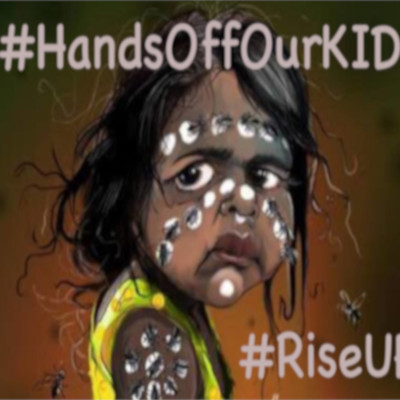
Land Destruction
Our lands and waters have been severely damaged by the actions of colonisers. It started with clearing of trees to make way for farmland. Our drinking water supplies were fouled by farm animals. Our sacred sites were razored away with mining operations. This still happens today. Uranium mining has left country poisoned. Rivers and water sources have been over-exploited. Mismanagement of the land has led to catastrophic bushfires. Nuclear weapon testing in the 50s and 60s led to deaths and serious long-term health effects for Aboriginal people in test areas, and made their lands uninhabitable.

Frontier Wars
The Frontier Wars was a campaign by British settlers to drive Aboriginal peoples off their lands.
The British settlers arrived with the First Fleet in 1788. A penal colony was established at Port Jackson, which is now the site of the Sydney central buisiness district.
The penal colony gradually expanded outwards, and other colonies were established on Aboriginal lands across the region.
"Settlers" were granted land grants by the British. Initially, these land grants were limited, but after some time the British Crown ran a land grant system that effectively rewarded settlers in "clearing" the land - a euphamism for murdering or driving off Aboriginal people.
There were many, many massacres of Aboriginal people. The British Crown legally prosecuted the perpetrators of very few massacres, the most well known being the Myall Creek massacre.
A research team from The University of Newcastle has a project which is available online about the locations and details of the massacres.

Deaths in Custody
In 1987-1991 the Royal Commission into Aboriginal Deaths in Custody was held to investigate the causes of the high number of Aboriginal people dying in police custody.
The Royal Commission made many recommendations. But governments were extremely slow in implementing the recommendations. Some recommendations are still not implemented.
The failure of governments to implement the Royal Commission recommendations has cost many more Aboriginal lives over the last 3 decades, and much trauma to Aboriginal families and communities.
Aboriginal people are still fighting for the recommendations to be implemented in full.

Stolen Wages
Aboriginal labour built a lot of Australia's infrastructure, including railway lines, cattle stations and farms. But they were often not paid for their work. Their wages were held in trust accounts or dissapeared through corruption and state-sanctioned mismanagement. There is little difference between this system and slavery, even though Aboriginal labour was being stolen well after the British abolished slavery in 1833.
Today, Aboriginal people are still under paternalistic systems where their finances are controlled through punative cashless welfare cards and work-for-the-dole schemes. In these systems, recipients are forced to work for unemployment benefits, which is often hard labour and hazardous work. There is racial discrimination in the welfare system, where Aboriginal people are required to jump through more hoops than non-Indigenous people to recieve the same benefits.
While there has been some compensation paid for historical cases, the compensation does not go anywhere near covering the amount stolen.
Due to the above factors, the intergenerational nature of poverty and systematic governmental blindsightedness, Aboriginal people are stuck in an endless cycle of poverty.
You can read more in this article by Barkindji woman, Kirilly Dawn.

Sovereignty
Unlike other British commonwealth member states, the British never conducted a Treaty with the native inhabitants of the Australian territory.
For more information, read this excellent ebook by Kevin Gilbert.

Child Removals
Historically, Aboriginal children and babies were systematically and forcibly removed from their families by goverments and church groups in order to assimilate them into mainstream society. This was part of official government policy for many decades, purportedly for the welfare of the children. The policies greatly damaged families and individuals.
The problem never went away. Recent studies have shown that today, Aboriginal children are 10 times more likely to be removed from their families than non-indigenous children.

Land Rights

Constitutional Integration
Over recents decades, there has been many millions of dollars spent by the Australian government and other Australian institutions on various plans to integrate Aboriginal people into the constitution of Australia.
As stated in the 2017 Referendum Council Final report, which came from the largest consultative process of Aboriginal people ever conducted:
All Dialogues asserted the fact that Aboriginal peoples and Torres Strait Islander peoples never ceded their sovereignty. For this reason, delegates were not persuaded of the benefit of acknowledgement inside the Constitution.
Despite this, in this year 2023 under the latest scheme, there is a planned referendum to modify the Australian Constitution Act by adding a new section to recognise Aboriginal and Torres Strait Islander people in the constitution.
The consultation process in 2017 was directly funded by the Australian government and facilitated by people chosen by the Australian government. The options put on the table were all geared towards the government priority of recognition in the constitution. It was not about the priorities of the Aboriginal and Torres Strait Islander community.
There was no option for the delegates to say 'no'.
Many Aboriginal people still hold concerns about the effect these reforms will have on their sovereignty. While we have been reassured the reforms will not diminish nor cede sovereignty, there has been little to no explanation on how the reforms will affect Aboriginal sovereignty.
Given the lack of this crucial information and the well-founded lack of distrust in proposals put forward by the government, we will continue to stand against constitutional integration.
